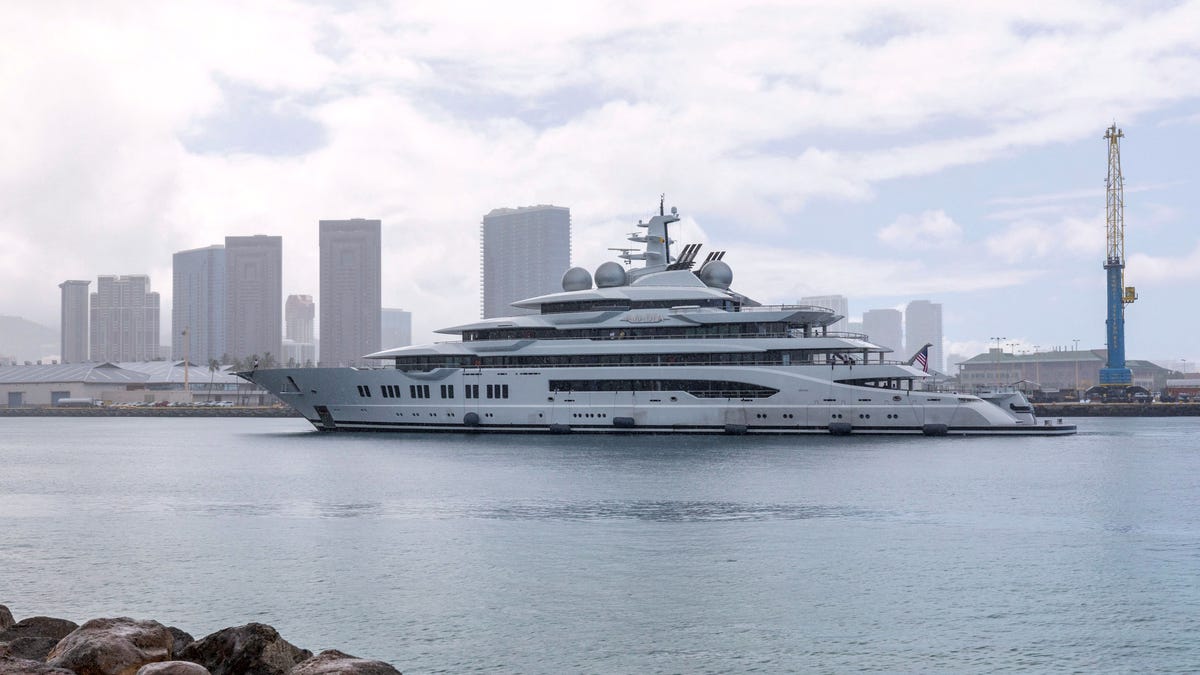Rich Guy Yachts Just Keep Getting Longer

The $300 million Amadea, linked by the United States to billionaire Russian politician Suleiman Kerimov, a target of sanctions, was impounded on arrival in Fiji in April at Washington’s request.Photo: Eugene TANNER / AFP (Getty Images)
In case you need an even stronger indication that normal people are being taken for a ride in late-stage capitalism: historic inflation is being accompanied by a worldwide boom in the number of billionaires. All these new members of the ultra wealthy are buying super, mega and “giga” yachts to set them apart from land-based poors.
There are so many deeply incredible and infuriating pieces of information from this New Yorker story about the world of private yachts that I’m going to encourage you to spend time reading the whole in-depth piece. Here’s a few bits that caught my eye, like describing a different kind of embarrassment of riches: having too small a yacht.
A big ship is a floating manse, with a hierarchy written right into the nomenclature. If it has a crew working aboard, it’s a yacht. If it’s more than ninety-eight feet, it’s a superyacht. After that, definitions are debated, but people generally agree that anything more than two hundred and thirty feet is a megayacht, and more than two hundred and ninety-five is a gigayacht. The world contains about fifty-four hundred superyachts, and about a hundred gigayachts.
For the moment, a gigayacht is the most expensive item that our species has figured out how to own. In 2019, the hedge-fund billionaire Ken Griffin bought a quadruplex on Central Park South for two hundred and forty million dollars, the highest price ever paid for a home in America. In May, an unknown buyer spent about a hundred and ninety-five million on an Andy Warhol silk-screen portrait of Marilyn Monroe. In luxury-yacht terms, those are ordinary numbers. “There are a lot of boats in build well over two hundred and fifty million dollars,” Jamie Edmiston, a broker in Monaco and London, told me. His buyers are getting younger and more inclined to spend long stretches at sea. “High-speed Internet, telephony, modern communications have made working easier,” he said. “Plus, people made a lot more money earlier in life.”
A Silicon Valley C.E.O. told me that one appeal of boats is that they can “absorb the most excess capital.” He explained, “Rationally, it would seem to make sense for people to spend half a billion dollars on their house and then fifty million on the boat that they’re on for two weeks a year, right? But it’s gone the other way. People don’t want to live in a hundred-thousand-square-foot house. Optically, it’s weird. But a half-billion-dollar boat, actually, is quite nice.” Staluppi, of Palm Beach Gardens, is content to spend three or four times as much on his yachts as on his homes. Part of the appeal is flexibility. “If you’re on your boat and you don’t like your neighbor, you tell the captain, ‘Let’s go to a different place,’ ” he said. On land, escaping a bad neighbor requires more work: “You got to try and buy him out or make it uncomfortable or something.” The preference for sea-based investment has altered the proportions of taste. Until recently, the Silicon Valley C.E.O. said, “a fifty-metre boat was considered a good-sized boat. Now that would be a little bit embarrassing.” In the past twenty years, the length of the average luxury yacht has grown by a third, to a hundred and sixty feet.
Or this portion, describing the amount of both pollution and wealthy self-awareness generated by these giants:
Even before Russia’s invasion of Ukraine, the yachting community was straining to manage its reputation as a gusher of carbon emissions (one well-stocked diesel yacht is estimated to produce as much greenhouse gas as fifteen hundred passenger cars), not to mention the fact that the world of white boats is overwhelmingly white. In a candid aside to a French documentarian, the American yachtsman Bill Duker said, “If the rest of the world learns what it’s like to live on a yacht like this, they’re gonna bring back the guillotine.”
But what these big-ass boats really represent to their ultra-wealthy owners is the largest waste of money possible, or as Silicone Valley CEO put it, ““absorb the most excess capital.”
The latest fashions include imax theatres, hospital equipment that tests for dozens of pathogens, and ski rooms where guests can suit up for a helicopter trip to a mountaintop. The longtime owner, who had returned the previous day from his yacht, told me, “No one today—except for assholes and ridiculous people—lives on land in what you would call a deep and broad luxe life. Yes, people have nice houses and all of that, but it’s unlikely that the ratio of staff to them is what it is on a boat.” After a moment, he added, “Boats are the last place that I think you can get away with it.”
Even among the truly rich, there is a gap between the haves and the have-yachts. One boating guest told me about a conversation with a famous friend who keeps one of the world’s largest yachts. “He said, ‘The boat is the last vestige of what real wealth can do.’ What he meant is, You have a chef, and I have a chef. You have a driver, and I have a driver. You can fly privately, and I fly privately. So, the one place where I can make clear to the world that I am in a different fucking category than you is the boat.”
Check out the whole story to see how the other side lives. It might motivate you to sharpen up the old guillotine blades while you’re at it.



